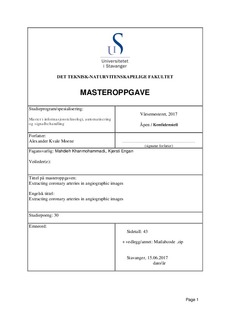Extracting coronary arteries in angiographic images
Master thesis
Date
2017-07-15Metadata
Show full item recordCollections
- Studentoppgaver (TN-IDE) [850]
Abstract
This master thesis has as propose to extract coronary arteries form angiographic video. With several stability issues with the easy to implement established functions in the time domain and other methods that is far too extensive to implement in the short time span. The focus turned to create a method that is easy to use over an image sequence by using information gathered in the time domain.
Uneven illumination is dealt with by homomorphic filtering and static noise as bone and cables are removed by subtraction the median image found in the time domain. The image is then over segmented by using SLIC superpixels that cluster around the arteries.
By tracking the movement in the images over time it is possible to divide the image into a dynamic part and static part. Then by observing noise in the static part the noise in the dynamic part can be kept at acceptable levels and the threshold level can be automatically adjusted each frame if needed by observing noise in the static area. From this function three binary images are made with different noise levels.
The 1st image is combined with the superpixel image and the occupancy in each superpixel determine if the superpixel area is of interest or not. After the initial segmentation is done a growing superpixel segment is seeded a from the edges of the static dynamic mask as the contrast agent needle is always connected to the edge of the screen and expands by observing the neighbouring superpixels.
The binary images are then combined with the fully grown superpixel image and through an incremental growth based on the binary images the final segmentation is achieved.
The result is a method that simplified the problem to a contrast problem and can be improved with Watershed method and active contours to increase the segmented area.
Description
Master's thesis in Cybernetics and signal processing
